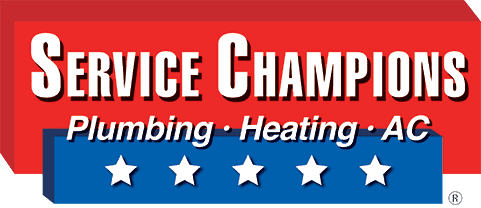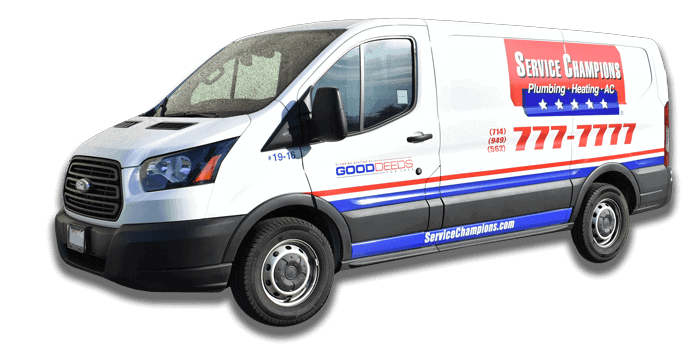Five Most Common Furnace Problems
Central air systems are an invaluable part of our homes, protecting us from extreme weathers and providing a warm or cool place to be whenever we need it.
Furnace Closet Installation
Despite their ability to keep us comfortable and dry, sometimes they display some unusual behavior. To help demystify some of the most common behavioral problems, Service Champions technicians explain what’s happening with your furnace on a technical level and what you can do before your technicians arrive for support.
When Your Furnace Blows Cold Air …
There are two main reasons why your furnace blows cold air instead of warmed air. The primary reason is ignition failure. When your ignition fails, the system has no source of heating energy.
A simple way to reset your furnace ignition is to go to your thermostat and turn the central air system off. Wait for a while, then turn the system back on. This usually restarts the entire process.
Another possible reason for cold air is if there are air bubbles in the gas line, which also stalls proper ignition. For the sake of your safety and the health of the central air system, enlisting in the help of your preferred HVAC contractor is a good idea when dealing with gas lines. The central air system is a complex system that uses gas, electricity and even water, so be sure to refrain from making any severe DIY alterations and quick fixes.
When Your Furnace Leaks Water…
Though the presence and/or collection of water are far more common and acceptable with air conditioning, it is not entirely abnormal for heating.
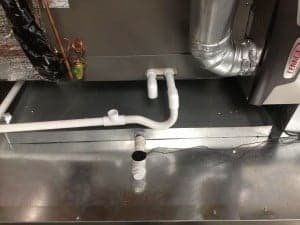
Clean Drip Pan
Trends indicate that newer high efficiency furnaces produce water while heating. With any type of central air system, drainpipes are employed to ensure proper water drainage, leading to an exterior exit point, usually located around the foundation of the home or under a sink attached to the home’s drain system.
Furnaces can leak water because drain pipelines are clogged with yard waste or other debris. There might be a cracked hose inside of the furnace, the collector box or the heat exchanger. Cracked hoses leak water and compromise drain systems, imperative to the central air system’s safe function.
Leaky furnaces require immediate attention from professional HVAC contractors as persistent leaks can damage the home. Water pooling together can rot woodwork, ceilings, floors and even prompt microbiological growth if left unattended long enough.
While waiting for your technician, what you can do is locate the drainpipe’s exit location. Clear it of dirt and yard waste to allow easy dispersal for whatever water travels its way.
When Your Furnace Won’t Turn Off…
Furnaces that will not turn off usually fail to do so because of electrical problems within the control system. The best thing to do in this situation is turn off the gas supply to the furnace. To do this, find your furnace closet or alcove. Next to the furnace, you will find a valve, colored red or yellow. Turn the valve so that it is perpendicular to the gas pipe. Now that you have stopped feeding gas into the furnace, contact your HVAC technician to come for further evaluations.
You may find that even after turning off the gas valve, the central air system continues to run. The air coming in through the ceiling registers should not be heated, though the fan may still be rotating.
If you find that this is what’s happening, a secondary issue lies within the fan motor and power to the fan can easily be cut off to stop the fan. The method simply depends on the furnace type.
Some furnaces contain a plug inside of the furnace closet. Other furnaces that are hardwired feature switches that you can turn on and off. If there is no switch or plug, then the furnace has been wired directly to the home. In order to disconnect power, visit the electrical breaker or fuse box. There you will find a switch or button marked “Furnace” or “FAU” (an acronym for “forced air unit”). Turn the switch to the off position and the breaker will shut down all power supply to the furnace. Call your HVAC technician for assistance and repair.
When Your Furnace is Loud …
There are several answers as to why your furnace may be uncharacteristically loud.
When and if the burners are over-firing, they grow loud because the gas pressure is too high. In other circumstances, a failing motor creates noises commonly described as whiny vibrations.
In newer high efficiency furnaces, the airflow is under greater restriction because the air filter has finer pores through which air can (or cannot) pass. To compensate for slower airflow, blowers tend to run higher and faster to overcome these restrictions, causing vocal sounds during air conditioning and heating.
Older furnaces also tend to be more vocal but from different causes. As parts wear out and grow weak, they don’t perform with the same type of technical accuracy, making room for clamor. Dirty blower wheels, worn burners and weak gas valves are all common culprits of a noisy furnace.
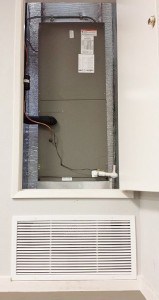
Air Handler – Split System
Apart from traditional gas furnaces, a heat pump split system also carries the potential for noisy performance. This electric method for heating and air conditioning is composed of the air handler, and heat pump condenser. Though the air conditioning process for the heat pump runs similarly to that of a standard gas heat air conditioner system. It is the method of heating for the heat pump split system that causes some noise.
In order to heat the home, the heat pump split system’s outdoor condenser contains a special valve. The reversing valve reverses the flow of refrigerant and the roles of the outdoor condenser and indoor evaporator coils. What results is that the indoor evaporator coil now becomes responsible for dispensing heated air into the home and the outdoor condenser unit is responsible for dumping cold air out as it absorbs heat. Due to the nature of how the different pressures work between these two instruments, when the heat pump split system is in heat mode, it tends to be louder than when in cool mode.
Five Problems Common to Furnaces
The main problems our technicians find on a day-to-day basis are all related to lack of proper maintenance:
- Dirty filters cause the furnace to overheat. Replacing filters regularly prevents overspending of energy.
- Dirty blowers lacking attention also cause furnace overheating.
- Dirty air conditioning evaporator coils prompt overheating and microbiological growth.
- Leaky duct systems make the furnace run excessively and wear parts out prematurely.
- Undersized returns and supply duct systems cause low air flow, overheating and poor performance.
Regular furnace maintenance, once a year, prevents costly repairs and replacements while restoring health, sanitation, safety and performance quality.
Service Champions Cares for Your Furnace
Our promise for top-tier furnace care has brought high quality central air to every home that chooses Service Champions.
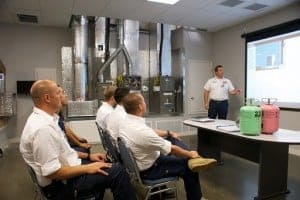
Service Champions technicians train annually for 150 hours each year, keeping their technical skillset up to date with the latest technology. This is how our experts service your central air system with the most intelligent and advanced methods of care. They also pass drug tests and background checks. For your additional security, we send you an e-mail containing the photo IDs of your technicians prior to their arrival.
Service Champions team members and on-field technicians bring you the most reliable heating and air conditioning service in California with superior customer service. We lead HVAC contractors in heating and air conditioning repairs, maintenance, tune-ups and installations and remain the only Diamond Certified HVAC providers in Orange and Los Angeles counties.
